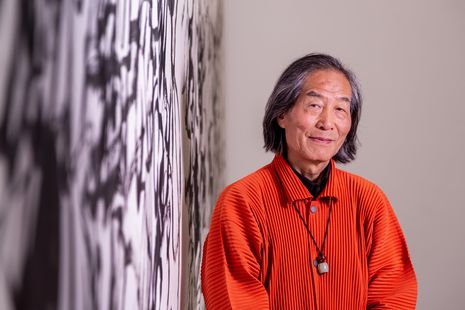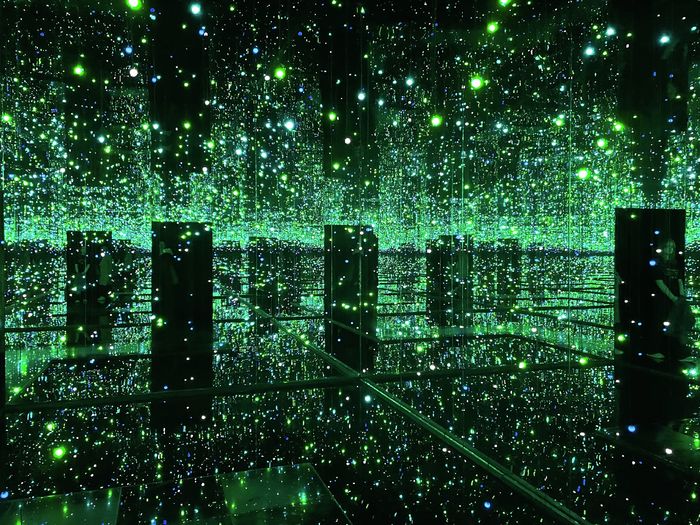It’s time to rethink calligraphy: the cosmic chaos of Ink. Space. Time. at the Heong Gallery
Tomos Davies enjoys an evening entangled in an exhibition of calligraphy as captivating as its creator

By curator Holly Roussel’s own admission, the Heong Gallery is a humble setting for Wang Dongling’s latest exhibition of contemporary Chinese calligraphy. From the British Museum to the Met, the Guggenheim to the V&A, Wang’s monumental pieces have dazzled gallery-goers the world over. And yet as I sat in Downing College’s Howard Theatre to listen to the artist’s opening remarks, I was struck by the sincere passion which the seventy-eight-year-old clearly retains for his ancient craft. His animated hand gestures amply compensated for the lag of a speech delivered via translation. So too did his bright red yeezys – a nod perhaps to the rebellious spirit of a man willing to bend stylistic norms.
“Who knew calligraphy could draw a crowd?”
Classically-trained, Wang Dongling has forged a path as the pioneering practitioner of ‘luan shu’: chaos script. The regimented line spacing of traditional calligraphy is a far cry from luan shu’s entanglement, leaving the final compositions illegible, while lending them a liberated, kinetic quality. Some appear geometric, though others take on natural forms. According to his granddaughter, it is as if the characters are having a fight on the paper. Wang’s enthusiasm on stage is mirrored by the energy which he brings to his live demonstrations. Visitors thronged to see a display of chaos script in action, reduced to a reverent hush as jumbled characters rapidly materialised on the artist’s plexiglass canvas. Who knew calligraphy could draw a crowd?
Though deeply rooted in the heritage of Chinese calligraphy, Wang considers himself a modern artist. His source material is transposed beyond comprehension, reflecting an interest in the aesthetic and material dimensions of writing. I was reminded of the late Franz Kline’s monochrome abstracts. Both artists embrace the rawness of mark making, with large-scale works characterised by fluid brushstrokes and a disregard for representation. At the same time, there is a softness to luan shu which is missing from Kline’s raucous paintings. As Wang emphasises, the Chinese script allows and embraces variation, allowing him to communicate the full spectrum of emotions. Robbed of their individual meaning, it is the interaction of characters that creates the sense of harmony so indicative of Wang’s artwork. However crowded his compositions may be, they articulate an underlying rationality which is grounded in the rules of an art form that can trace its origins back three thousand years.
“To stare at Wang’s work is as if to gaze at the night sky”
Ink. Space. Time. brings together site-specific works inspired by the intellectual history and physical environment of Cambridge. Wang invites us to look to the stars, displaying extracts from Stephen Hawking’s A Brief History of Time opposite the writings of Daoist philosopher, Laozi. Also present are texts by William Wordsworth, Lord Byron, and Xu Zhimo. The intersection of philosophy and science, art and literature, allows Wang to recall the celestial, portraying the chaos of our cosmos through his dizzying installations. His calligraphy is consciously inaccessible. Its forms are unintelligible, and its clutter overwhelming. To stare at Wang’s work is as if to gaze at the night sky; it is to accept complexity and to relish in incredulity.
Working at a vast scale, Wang embodies the physicality of his artwork. He moves with impressive agility, demonstrating a deftness that allows him to convey both the dynamism and tonal subtlety of luan shu. Drawing on each of his seven decades of experience, Wang manipulates his tools with complete intent, the flow of his brush uninterrupted as it sweeps over the page. Most remarkably, he has never stopped innovating. From rice paper to wood, plexiglass to photographic developer, he experiments with an array of materials. Inventive yet unpretentious, the moniker ‘master calligrapher’ has never seemed so fitting.
“Indecipherable for English and Chinese speakers alike, Wang’s writing is transformed into a dialogue between nature and abstraction”
Visiting Ink. Space. Time. felt like a genuinely profound experience. Indecipherable for English and Chinese speakers alike, Wang’s writing is transformed into a dialogue between nature and abstraction, evoking awe and disorientation in equal measure. The artist seems determined to bring calligraphy into the mainstream, quipping that he hopes the discipline will become as recognisable as Kung Fu. It certainly has a history to rival that of the martial art. With this exhibition, the Heong Gallery once again punches above its weight, attracting world-class artwork into its intimate space. This is a show which reveals the creative process of an artisan at the peak of his powers. Don’t miss it.
‘Ink. Space. Time.’ is at the Heong Gallery until 27 August, open Wednesday–Sunday 12–5.
 News / Cambridge postgrad re-elected as City councillor4 May 2024
News / Cambridge postgrad re-elected as City councillor4 May 2024 News / Gender attainment gap to be excluded from Cambridge access report3 May 2024
News / Gender attainment gap to be excluded from Cambridge access report3 May 2024 Comment / Accepting black people into Cambridge is not an act of discrimination3 May 2024
Comment / Accepting black people into Cambridge is not an act of discrimination3 May 2024 News / Academics call for Cambridge to drop investigation into ‘race realist’ fellow2 May 2024
News / Academics call for Cambridge to drop investigation into ‘race realist’ fellow2 May 2024 News / Some supervisors’ effective pay rate £3 below living wage, new report finds5 May 2024
News / Some supervisors’ effective pay rate £3 below living wage, new report finds5 May 2024




